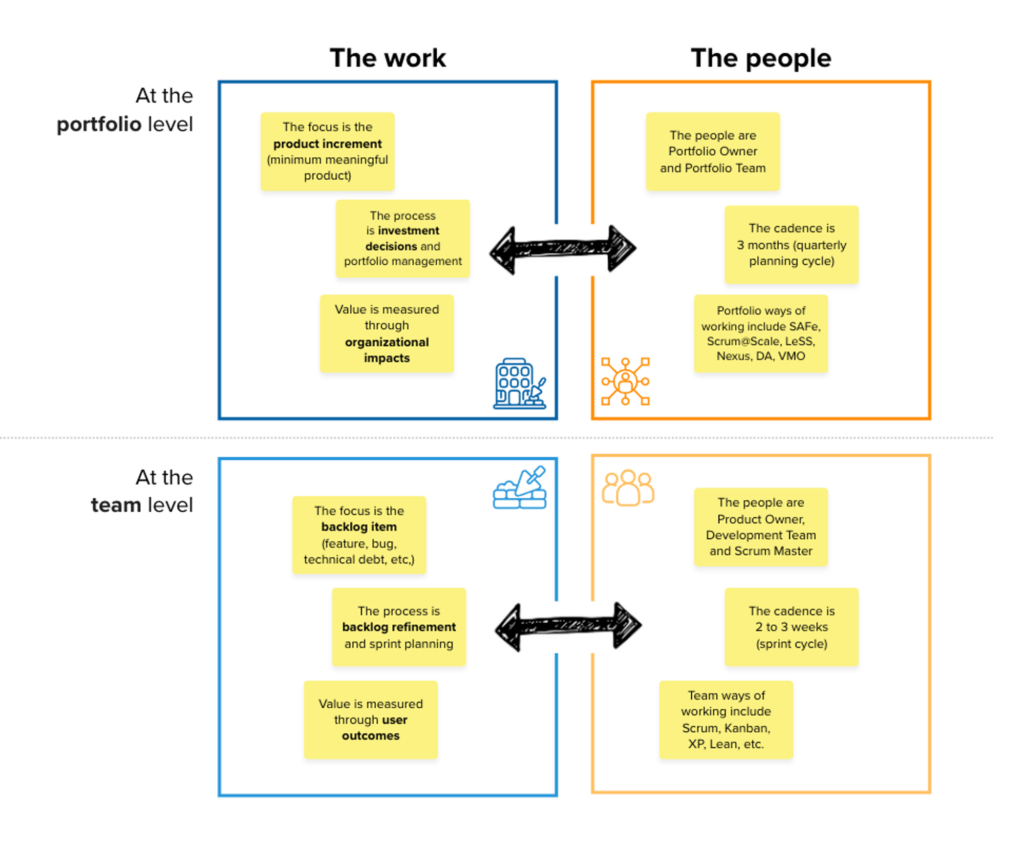Scaling Agility up to the Portfolio Level
Implementing agility at the portfolio level can seem daunting. However, many of the agile practices developed for the team level can be scaled up to the portfolio level.
For example: For an agile delivery team, the units of work are the backlog items. These items are managed in a prioritized product backlog. Each sprint, the delivery team reviews the work and pulls the highest value items into the sprint. The person managing the product is focused on delivering value to their users.
For an agile portfolio team, the units of work are product increments. The increments are managed in a prioritized portfolio backlog. Each quarter, the portfolio team reviews the work and pulls the highest value increments into implementation. The people managing the portfolio are focused on delivering value to the organization.

Whether you are working at the team level or at the portfolio level, the key question is “What is most valuable for us to build now?” To answer this question, you need a set of options and a clear process for making trade-off decisions.
There are a range of agile prioritization models you can use to make these decisions. Some models are best suited to prioritizing work in the product backlog:
- With the MoSCoW approach, you group features into four categories: must have, should have, could have, and won’t have.
- With the Kano approach, you analyse features by user satisfaction and functionality, grouping them into five categories: must have, performance, attractive (also called delighters), indifferent, and reverse.
- In the Eisenhower approach, you create a 2×2 matrix based on importance and urgency, where quadrant 1 is urgent and important, quadrant 2 is important, but not urgent, quadrant 3 is not important but urgent, quadrant 4 is neither important nor urgent.
In the portfolio space, you need prioritization approaches that support larger investment decisions:
- Reach, Impact, Confidence, Effort (RICE) is a scoring model developed by Intercom that uses four factors to assess options: Reach (how many people your product or initiative will reach in a certain time frame) + Impact (how much impact do we expect) + Confidence (your confidence in your estimates of reach and impact) divided by Effort (number of resources needed, typically expressed in person-months).
- Weighted Shortest Job First (WSJF) is lightweight scoring model that focuses on the cost of delay. Cost of delay is based on three factors: business value, time criticality, risk reduction/opportunity enablement. Then the cost of delay divided by job size. The power of WSFJ comes from using relative scores, instead of estimates. You can use scores from 1 to 10, 1 to 100, or the Fibonnaci sequence (1,2, 3, 5, 8, 13, etc). Lay out your investment candidates (aka product increments) in a table. To assign scores, compare the options against each other. Don’t assign scores to each option in isolation.
If these models don’t meet your needs, your can create your own prioritization process. Use three to five key factors (no more than eight) and experiment with using relative scores. You want to keep the prioritization process lightweight and understandable.
Whatever prioritization process you decide to use, make sure decision-makers practice using it so everyone understands how it works and how you want to digest the results. Ideally, you want to put the prioritization process on a wall (real or virtual) so people can stand side-by-side and discuss the work together, rather than face each other and argue.
If you’d like some help setting up your prioritization process, give us a shout.

